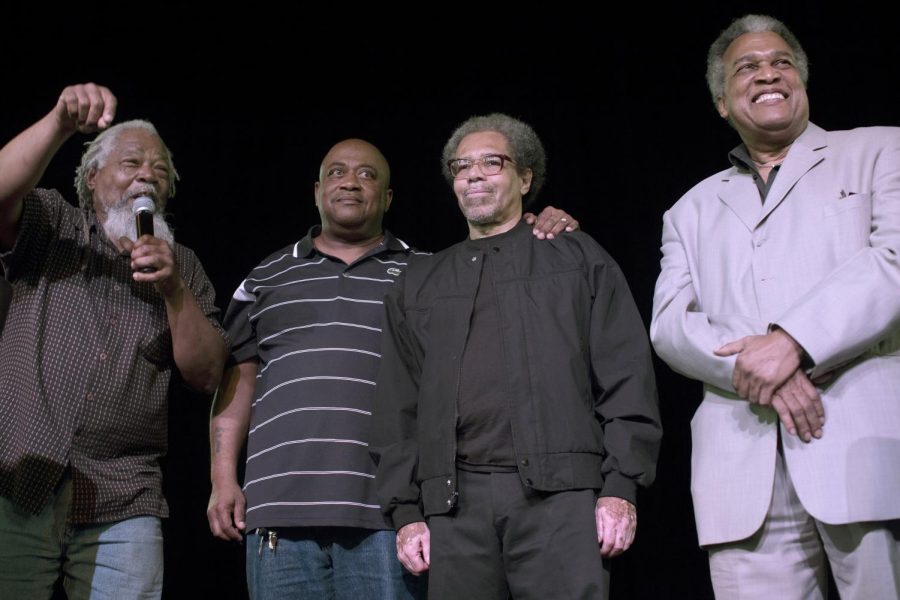Mass incarcerated suffer in solitary confinement
Albert Woodfox, second from right, stands with his brother Michael Mable, second from left, as he is introduced by Malik Rahim, right, and Parnell Herbert, right, at the Ashe Cultural Arts Center in New Orleans, Friday, Feb. 19, 2016. Earlier today Woodfox, the last of three high-profile Louisiana prisoners known as the “Angola Three,” was released from Louisiana State Penitentiary in Angola, La. (AP Photo/Max Becherer)
September 4, 2022
Albert Woodfox, a member of the Black Panther Party who spent 43 years and 10 months in solitary confinement for a crime he didn’t commit, died Aug. 4 this year at 75 years old.
Woodfox died just six years after his release from prison, and his time in solitary confinement may have been the longest-recorded in U.S. history.
His death has sparked conversations about mass incarceration and solitary confinement among criminology researchers, including members of the Loyola community.
“It’s essentially torture,” said Christian Bolden, a Loyola criminology and justice professor, of Woodfox’s imprisonment.
The Angola 3
Woodfox was a part of the Angola 3, a group of men who were incarcerated in solitary confinement at the Louisiana State Penitentiary, colloquially referred to as Angola. The men incarcerated with Woodfox were Robert King and Herman Wallace.
The Angola 3 have long campaigned against the cruel practice of solitary confinement, as well as for the release of prisoners who were wrongfully convicted and incarcerated.
These men maintained a positive outlook while they were incarcerated, despite their being in solitary confinement. They also organized strikes and protests with other incarcerated people to protest their conditions, according to the Angola 3 website.
On solitary confinement
Bolden spoke to the men’s years of solitary confinement and the effects the conditions had on them.
“There’s a loss of interpersonal skills, a loss of life skills, not being able to interact with people.” Bolden said. “Thrusting them inside a cell by themselves doesn’t solve the problem.”
Marcus Kondkar, the director of the Loyola prison education project, seconded Bolden’s sentiments, claiming that there are many negative psychological impacts on those who are subjected to solitary confinement.
Kondkar said that solitary confinement has been shown to trigger or exacerbate depression, anxiety, and paranoia. It is also associated with much higher rates of self-harm, suicide ideation and suicide attempts, he added.
Kondkar is one of the creators of the Visiting Room Project, a digital experience that allows viewers to hear the stories of incarcerated people who are serving life sentences without the possibility of parole. The site contains over 100 detainee interviews filmed at Angola, the largest prison in the U.S.
“Most of the folks I interviewed who had experienced prolonged periods of solitary confinement described most of these symptoms, in addition to feelings of claustrophobia and cognitive/perceptual distortions,” Kondkar said.
Kondkar added that detainees in confinement often self-harm as a way to “feel something,” due to the sensory deprivation they experience. He also said that long-term confinement creates problems when faced with reintegration back into society.
“So, paradoxically, solitary confinement actually magnifies the problematic behaviors it is purportedly trying to address,” he said.
A broken system
The U. S. has the highest prison population in the world, and incarceration and lengthy periods of solitary confinement are the most common punishments for those found guilty of crimes, according to a report done by the Prison Policy Initiative.
The Angola 3 were imprisoned in solitary confinement for a total of 114 years, after being wrongly convicted for the murder of a prison guard and for speaking out against the maltreatment which took place in various prison facilities, particularly at Angola, according to the Angola 3 website.
The Angola 3 were described as “courageous people who knew and spoke out about the injustice that Angola was running” by Vidal Amador-Flores, a Loyola psychology senior who gave his thoughts on the three men.
“It’s fear. It’s anxiety ridden. It’s essentially a single cell with little-to-no meaningful contact with any other people, and that within itself is just terrible,” he said of solitary confinement.
A group most don’t know
While the Angola 3 and their miraculous survival through years of confinement have inspired many, they are still largely forgotten by the prison community and the public due to their severe isolation, according to Kondkar.
Bolden said he wishes that more people knew about the Angola 3 and believes there would be an uproar if more people knew. He teaches a class on mass incarceration at Loyola and said that when he lectures about the Angola 3, most students are shocked that they have never heard of the men before.
“It’s such an extreme human rights violation,” Bolden said. “It’s unimaginable, all of that time stuck by yourself in a small cage.”
Since the incarceration of the Angola 3, there have been numerous lawsuits and campaigns to stop the torture that these circumstances entail; however, the struggle for justice for these isolated individuals is still ongoing, according to the Angola 3 website.








